Dan Kaplan is a champion of sustainable design and contextual architecture rooted in an urban landscape. A senior partner at FXCollaborative (formerly FXFOWLE) where his career has flourished for close to three decades, he’s also design director of the firm’s Urban Studio, which “bridges the realms of architectural design, urban planning, and sustainable innovation.” Kaplan designs his buildings firmly within the context of the surrounding city.
Some of the most notable New York projects Dan has worked on include the LEED Gold certified office tower Eleven Times Square, mixed-use hybrid 35XV (LEED Silver anticipated), and the downtown residential development, The Greenwich Lane (LEED-ND Gold Pre-Certified, LEED Silver anticipated). Kaplan also remains committed to teaching as a co-chair of the Dean's Advisory Board/Visiting Lecturer at Cornell's College of Architecture where he teachings a graduate class exploring the relationship between design and environmental performance in urban buildings. Ahead he speaks to CityRealty about his work over the years and the importance of creating a sustainable environment.
Some of the most notable New York projects Dan has worked on include the LEED Gold certified office tower Eleven Times Square, mixed-use hybrid 35XV (LEED Silver anticipated), and the downtown residential development, The Greenwich Lane (LEED-ND Gold Pre-Certified, LEED Silver anticipated). Kaplan also remains committed to teaching as a co-chair of the Dean's Advisory Board/Visiting Lecturer at Cornell's College of Architecture where he teachings a graduate class exploring the relationship between design and environmental performance in urban buildings. Ahead he speaks to CityRealty about his work over the years and the importance of creating a sustainable environment.
Your firm was founded on the principles of sustainable design. How has that changed over the last few decades?
Dan: When we first started looking at sustainable buildings, it was all about the grouping of performance issues, whether it was energy reduction, or indoor air quality, or daylighting. Aside from energy reduction, which has a little ways to go, most of the baseline performance issues are either being adopted by the code or general good practice. So when we first did 4 Times Square, low chemical emitting products were revolutionary. In buildings now, it’s commonplace.
Where we see the really interesting things happening now are in three places. First and foremost, it’s all about city building and creating green urbanism, because concentrating people into environments in a transit-oriented infrastructure and a dense amenity-rich context is more environmentally responsible than the performance of any given building.
Where we see the really interesting things happening now are in three places. First and foremost, it’s all about city building and creating green urbanism, because concentrating people into environments in a transit-oriented infrastructure and a dense amenity-rich context is more environmentally responsible than the performance of any given building.
Concentrating people into environments in a transit-oriented infrastructure and a dense amenity-rich context is more environmentally responsible than the performance of any given building.
The second area that’s interesting is: how do buildings speak? How do they convey sustainability? How do they tell the story of green buildings? And that to me is light, air, greenery, access to the outside, a looser, more informal relationship with the envelope of the building. We’re seeing this blossoming. It started in the outdoor realm of terraces, and walls that disappeared, and has quickly migrated into the commercial office realm. A long time ago, setbacks and terraces were unheard of in office spaces, and now it’s a requirement for offices to have access to outdoor space.
The third aspect of sustainability that has really changed is radically energy-efficient buildings. We are working on large projects that have a German standard called Passivhaus, which is utilizing around a fifth of the energy of regular buildings. We’re working on an application for large developments because it was originally developed for single-family houses.
The most interesting aspect is how all those three things interact in a dense urban context. Buildings that have a lot of porosity between inside and out and use a lot less energy—that’s a fertile formulation.
The third aspect of sustainability that has really changed is radically energy-efficient buildings. We are working on large projects that have a German standard called Passivhaus, which is utilizing around a fifth of the energy of regular buildings. We’re working on an application for large developments because it was originally developed for single-family houses.
The most interesting aspect is how all those three things interact in a dense urban context. Buildings that have a lot of porosity between inside and out and use a lot less energy—that’s a fertile formulation.
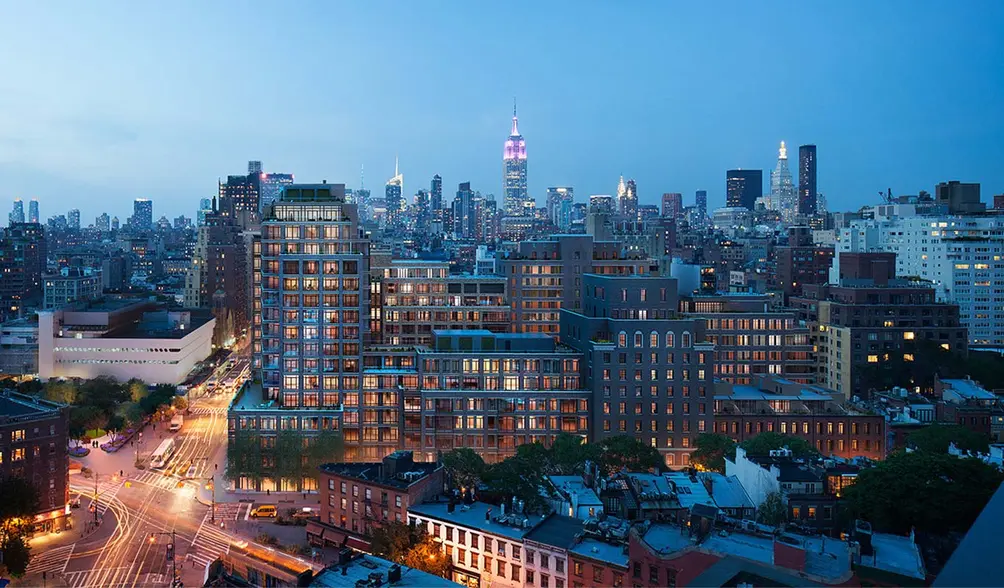 The Greenwich Lane
The Greenwich Lane
FXCollaborative has a signature style that is multi-dimensional, where every angle of the structure is distinctive. How did you apply this in a project like The Greenwich Lane?
Dan: We grew up professionally, literally and figuratively, in New York. When you are working in the dense grid of New York, it’s all about the perception of a building. You hardly ever get to see a building as a pure, freestanding object. It’s always oblique, or a corner, or fragmentary. It’s very hard to see these buildings just as isolated events. So we’re always thinking about the person on the street in the building we’re designing, how they perceive the structure and how it’s crafted into its context.
With The Greenwich Lane, what was really important to me was the scale change. When you come down 7th Avenue, the buildings are taller, and then you get to 12th Street, and they start to radically step down to the West Village, so by the time you get to 11th Street, it’s townhouse scale, and the buildings are set back farther, and it’s gentler. There’s a historical building, almost like a fragment, in the streetscape. And then there are five townhouses. So it’s an assemblage approach to composition and the scale perception of the person on the street.
With The Greenwich Lane, what was really important to me was the scale change. When you come down 7th Avenue, the buildings are taller, and then you get to 12th Street, and they start to radically step down to the West Village, so by the time you get to 11th Street, it’s townhouse scale, and the buildings are set back farther, and it’s gentler. There’s a historical building, almost like a fragment, in the streetscape. And then there are five townhouses. So it’s an assemblage approach to composition and the scale perception of the person on the street.
When working with older, landmarked structures like several buildings in The Greenwich Lane, what are the challenges in creating eco-friendly, sustainable design?
Dan: First of all, any preservation of historic fabric is a sustainable act in and of itself because you’re preserving all the embodied energy that goes into making the building.
We improve the windows from single-pane to double-pane, and we insulate the facade, but it has to be carefully done. Old buildings need to breathe, so they don’t deteriorate. We deal with the systems and put in all new HVAC. It’s a change of use. These buildings were a collection of all sorts of different medical uses, and now they feel like brand new condominium residential spaces on the inside out. It’s worth noting that we’re very proud that The Greenwich Lane received a LEED Neighborhood Development, meaning that it’s a complex of buildings that achieved LEED.
We improve the windows from single-pane to double-pane, and we insulate the facade, but it has to be carefully done. Old buildings need to breathe, so they don’t deteriorate. We deal with the systems and put in all new HVAC. It’s a change of use. These buildings were a collection of all sorts of different medical uses, and now they feel like brand new condominium residential spaces on the inside out. It’s worth noting that we’re very proud that The Greenwich Lane received a LEED Neighborhood Development, meaning that it’s a complex of buildings that achieved LEED.
I’m a modernist at heart, and there’s a lot of great architecture in the city, but I feel like there’s an overuse of the all glass building.
 The Greenwich Lane
The Greenwich Lane
We like the old brick, and stone, and sculptural details of New York architecture. Do you worry that we’re losing that?
Dan: I think it’s an issue. I’m a modernist at heart, and there’s a lot of great architecture in the city, but I feel like there’s an overuse of the all glass building. I had this epiphany. I was at Tate Modern in London, and I was looking out over London. There’s all this beautiful masonry. The light is actually very similar to New York light, it’s northern light, and the masonry buildings are beautiful and light, but all the modern glass buildings look black. I don’t care what the renderings show. You lose the depth and the texture. I’m certainly not advocating a return to traditional style, but the texture, craft, depth, shadow, rhythm—these, done with the modern hand, is what I think this city needs more of.
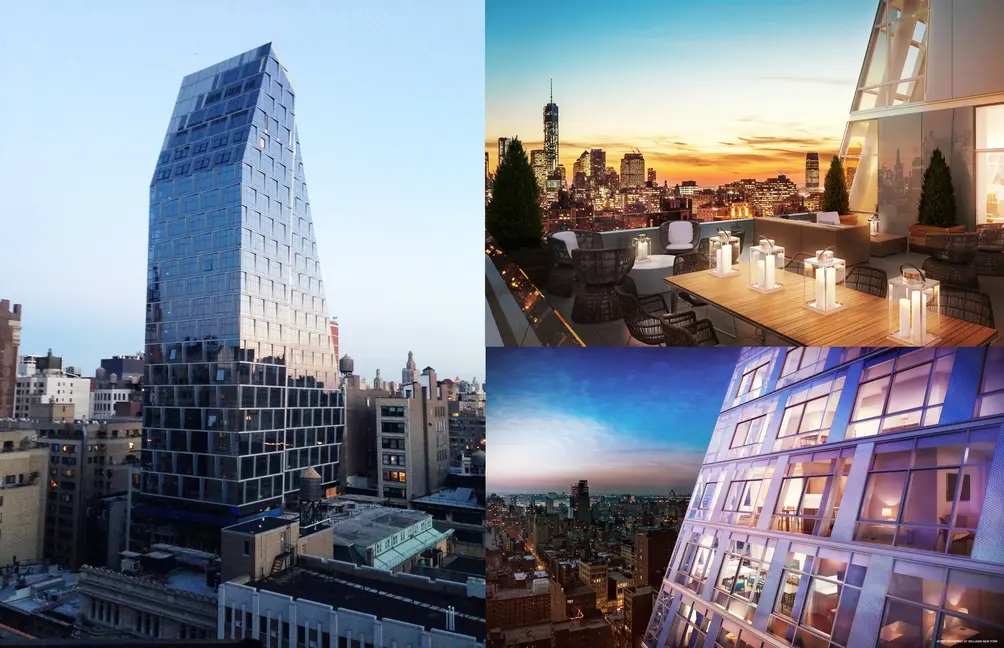 35XV. Images courtesy of the Urban Land Institute
35XV. Images courtesy of the Urban Land Institute
When you approach the design in a mixed-use building, like 35XV for example, do you have a formula for either integrating or individuating the design?
Dan: A lot of times when we have a mixed, hybrid building, what we want to do is give each piece its own identity. 35XV has a school at the bottom and a residential building above, but in this case, we wanted to make the whole building feel like one piece. It was more of a contextual response; we wanted the building to be grounded.
The building is a piece of sculpture that meets the sky. By creating a stone base, we grounded the building in the street but with a very modernist sensibility. It fit into the scale, rhythm, depth, texture of the street, but it’s clearly a modern structure. It’s stone and glass, and it picks up on the light. The building sets back, it’s angled, and it reflects the sky. It’s mostly glass, but it has some texture on it, so it changes a lot in the sunlight. It’s about having a dialogue with the changing color and conditions of the sky. On other mixed-use structures, we try to balance the individual identity of the various parts with the overall structure.
The building is a piece of sculpture that meets the sky. By creating a stone base, we grounded the building in the street but with a very modernist sensibility. It fit into the scale, rhythm, depth, texture of the street, but it’s clearly a modern structure. It’s stone and glass, and it picks up on the light. The building sets back, it’s angled, and it reflects the sky. It’s mostly glass, but it has some texture on it, so it changes a lot in the sunlight. It’s about having a dialogue with the changing color and conditions of the sky. On other mixed-use structures, we try to balance the individual identity of the various parts with the overall structure.
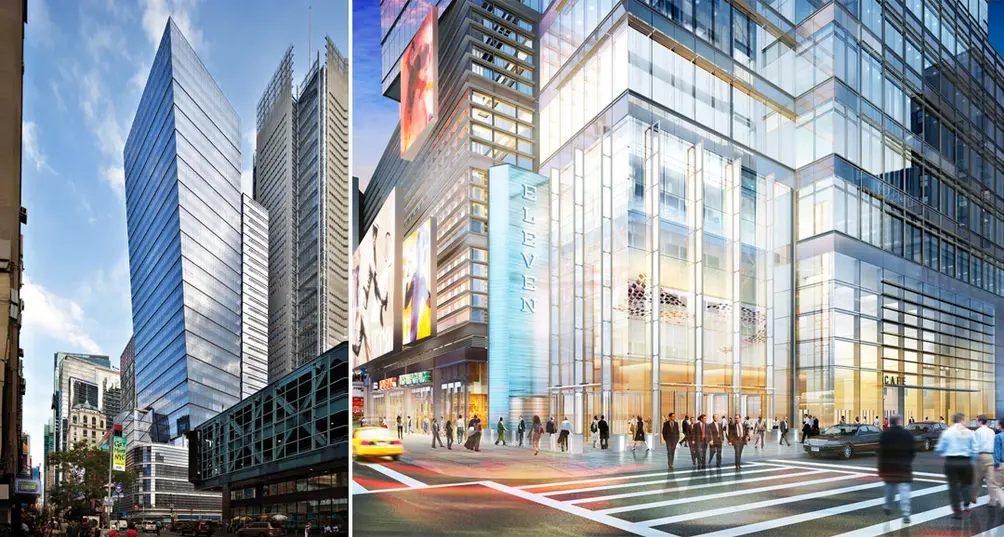 11 Times Square
11 Times Square
You’ve said that the canted facade of 11 Times Square opens up views for pedestrians. How does that work?
Dan: With 11 Times Square, there were three neighboring buildings important to see. One building is a historic building on the south side of 42nd Street. It has Coke bottle green glass (because the guy who developed it invented Coca Cola). The other buildings are the McGraw-Hill building, which is one of the all-time great New York buildings, and the New York Times building, which we are very involved with. The tower of 11 Times Square cuts in and then slopes out, so that when you’re on 42nd Street looking west, you still see the McGraw-Hill building, and when you’re at the McGraw-Hill building looking east, you still see the Candler Building, Looking south at the corner of 42nd and 8th Avenue, the building rotates and cants, so you still see the corner of the New York Times building.
A lot of architecture is doing no harm. One of the best things you could do is preserve something.
By turning and rotating and carving it, it was about maintaining view corridors. Sometimes in the office we say we have the Hippocratic Oath of architecture. A lot of architecture is doing no harm. One of the best things you could do is preserve something.
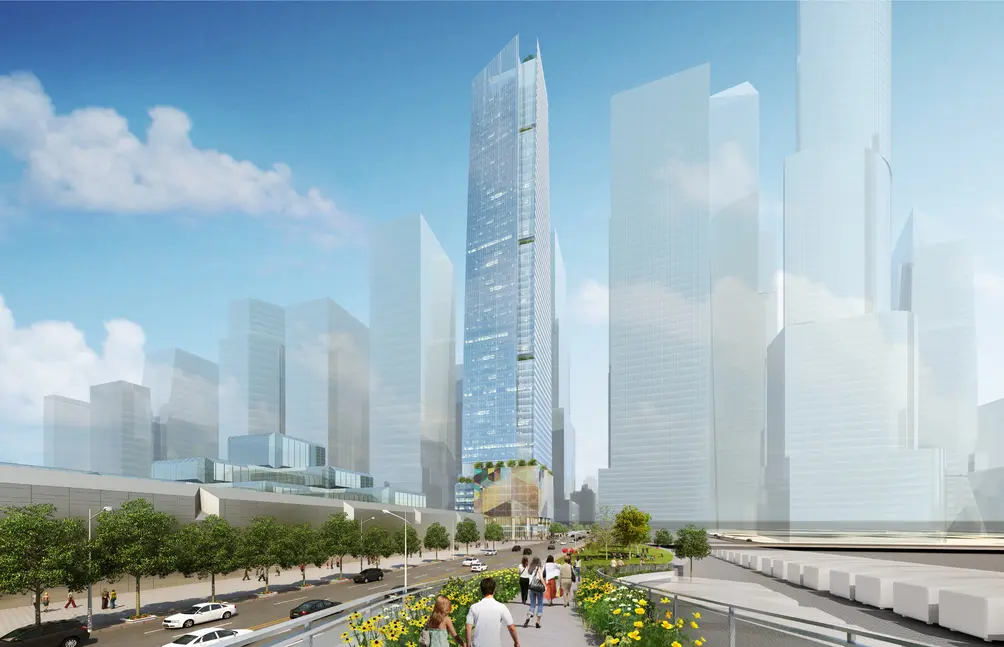 3 Hudson Boulevard
3 Hudson Boulevard
What’s on the horizon? What’s your next big project?
Dan: There are two things that are interesting. One is smaller scale and more crafted, a building called The Chamberlain. It’s a residential project on 87th Street between Broadway and West End. It’s a quiet, street wall building, but it clearly takes inspiration from the great art deco buildings of the 1920s on the Upper West Side where one could say the modern apartment building was invented.The other one that’s at the opposite end of the scale is 3 Hudson Boulevard, which is one of the Hudson Yards buildings. Ours is a singular tower on a full block on 34th and 11th Avenue fronting Hudson Boulevard. It’s a rare, once-in-a-lifetime opportunity to do a full block in Manhattan. In the contextual approach, we looked at the solar context, the fact that Manhattan is off true north/south by around 20 degrees, so the building torques as it goes up to meet true north/south directionality and gives better solar access for both daylight inside the building and also for the photovoltaic cells that are going to be on the outside of the building.
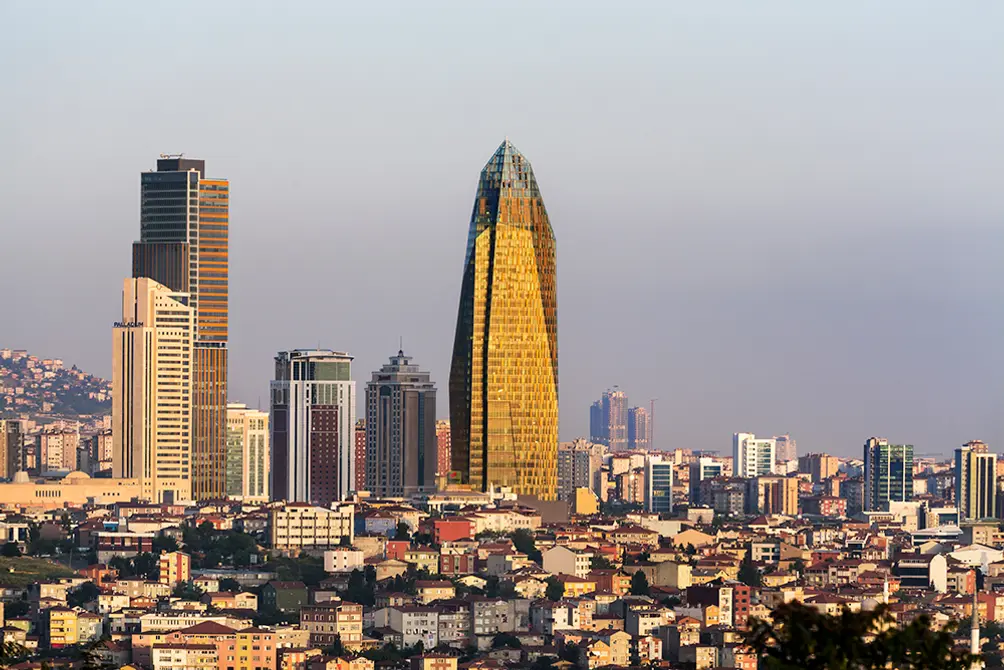 FXCollaborative's Allianz Tower in Istanbul
FXCollaborative's Allianz Tower in Istanbul
In all these projects, what are your ultimate concerns, and your approach, when designing in relation to the surrounding urban landscape?
Dan: We are at heart contextualists in that we totally believe in the power of the local culture and context. The best example of this is a building I just finished in Istanbul. I’m quite concerned about the “generic iconic.” It concerns me globally, a sort of homogenization. We decided that the tower in Istanbul had to be designed so that it could only be in Istanbul. It had strong references to the culture like the sun shading screens that harken back to the Islamic Mashrabiyas, which are lattice screens for shade and privacy, and the coloration of this golden scrim, and the pointed geometry. Yes, it’s a 21st century building, it’s a LEED Platinum international level high-rise, but it is firmly rooted in the local. That doesn’t mean we are replicating or taking at face value and reproducing the style or the motifs of a given context, but we are using the context — not just physical context, but the cultural and the environmental context as a springboard.I think when you line all our buildings up, there’s a sensibility that works together, but they all are pretty unique. I don’t think we have a prescribed style. We have a consistent approach, which is: look at what the environment is telling you, look at what the context is telling you, and apply a modern sensibility to transform that to a composition.
Editor's Note: This article was originally published on August 3, 2016. However, in honor of Earth Day, we retrieved this conversation with a sustainable design leader.

 6sqft delivers the latest on real estate, architecture, and design, straight from New York City.
6sqft delivers the latest on real estate, architecture, and design, straight from New York City.
